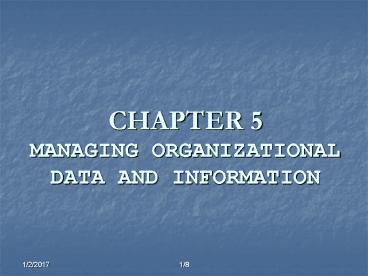CHAPTER 5 MANAGING ORGANIZATIONAL DATA AND INFORMATION - PowerPoint PPT Presentation
Title:
CHAPTER 5 MANAGING ORGANIZATIONAL DATA AND INFORMATION
Description:
chapter 5 managing organizational data and information ... – PowerPoint PPT presentation
Number of Views:57
Avg rating:3.0/5.0
Title: CHAPTER 5 MANAGING ORGANIZATIONAL DATA AND INFORMATION
1
CHAPTER 5MANAGING ORGANIZATIONAL DATA AND
INFORMATION
2
Basics of Data Arrangementand Access
- The Data Hierarchy
- Field - a logical grouping of characters into a
word, a small group of words, or a complete
number - Record - a logical grouping of related fields
- File - a logical grouping of related records
- Database - a logical grouping of related files
- Entity - a person, place, thing, or event about
which information is maintained - Attribute - each characteristic or quality
describing a particular entity - Primary Key - field that uniquely identifies the
record - Secondary Key - field that has some identifying
information, but typically does not identify the
file with complete accuracy
3
Problems with Traditional File Approach
- data redundancy
- data inconsistency
- data isolation
- security
- data integrity
- application/data independence
4
Database The Modern Approach
- Creating a Database
- Conceptual design - an abstract model of the
database from the user or business perspective - Physical design - shows the way a database is
actually arranged with a storage devices - Entity-relationship (ER) modeling
- process of planning the database design
- Entity classes ? Instance ? Identifiers ?
Relationships - Normalization
- method for analyzing and reducing a relational
database to its most streamlined form for minimum
redundancy, maximum data integrity, and best
processing performance
5
Database Management Systems
- A software program (or group of programs) that
provides access to a databases - Permits an organization to store data in one
location, from which it can be updated and
retrieved - Provides access to the stored data by various
application programs - Provides mechanisms for maintaining the integrity
of stored information, managing security and user
access, recovering information when the system
fails, and accessing various database functions
form within an application written in a
third-generation, fourth-generation, or
object-oriented language
6
DBMS Components
- 4 Main Components
- Data model
- defines the way data are conceptually structured
- Data definition language (DDL)
- defines what types of information are in the
database and how they will be structured - functions of the DDL
- provide a means for associating related data
- indicate the unique identifiers (or keys) of the
records - set up security access and change restrictions
7
DBMS Components (continued )
- Data manipulation language (DML)
- Structured query language (SQL) - most popular
relational database language - Data Dictionary
- stores definitions of data elements and data
characteristics
8
Company Data Models































